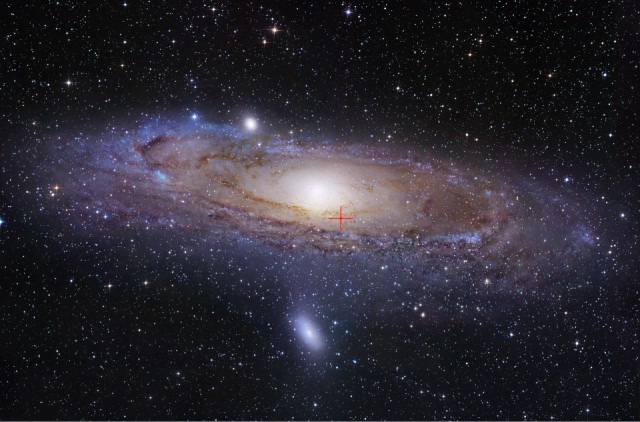
Some of the brightest objects in the Universe are supermassive black holes at the hearts of galaxies—black holes with masses millions or billions of times greater than the Sun. As matter falls toward these black holes, the system emits intense radiation, especially in the radio and X-ray portions of the electromagnetic spectrum. When light from the infalling matter reaches a maximum intensity, the systems are known as quasars, which are bright enough to shine out from the early Universe.
Stellar-mass black holes, which are "only" 5 to 20 times more massive than the Sun, can also produce intense light. However, interstellar gas absorbs and scatters the X-rays, making them difficult to spot. As a result, only four microquasars are known in the Milky Way, and we haven't been able to observe many details of them. No similar systems have been spotted in other galaxies—until now. Observers found the first microquasar in M31 (Andromeda Galaxy), the nearest large galaxy to the Milky Way.
Though black holes (either stellar-mass or supermassive) emit no light of their own, their intense gravity gathers matter around them. As charged particles such as electrons accelerate, they emit light; with the high acceleration rates around black holes, this light takes the form of X-rays and radio waves. (Even though X-rays are some of the highest energy radiation and radio waves are the lowest in energy, they are often produced by the same physical phenomena, and provide dual ways to observe some of the most violent events in the cosmos.)
The matter forms a rotating accretion disk around the black hole, and some is channeled into powerful jets streaming along the axis of rotation. The infalling particles in the disk interact with each other, so that pressure builds up within it. Eventually, it can build to the point where it pushes any additional matter away from the black hole. As a result, a black hole (or any other object) will reach a maximum brightness, known as the Eddington luminosity, named for the astronomer Arthur Eddington. Quasars are supermassive black holes shining at or near the Eddington luminosity, and microquasars are likely stellar-mass black holes whose accretion is similarly close to the theoretical maximum.
The orbiting XMM-Newton X-ray observatory discovered XMMU J004243.6+412519, a bright X-ray source in M31 in January 2012. Later, the object flared to a peak luminosity greater than 1032 Watts. For reference, the Sun's luminosity is 3.8×1026 Watts, including all types of light. In other words, this object emits roughly a million times the energy of our Sun in X-rays alone. If that wasn't enough, this particular microquasar was 10 times brighter than any other known object in M31.
Astronomers monitored the ultraluminous X-ray source (ULX) using the Swift and Chandra orbiting observatories for X-rays, along with the Jansky Very Large Array (VLA) in New Mexico, the Very Long Baseline Array (VLBA), and the Arcminute Microkelvin Imager Large Array (AMI-LA) for radio light. These observations allowed the researchers to rule out the possibility that the microquasar was actually a more distant background object peeking through M31's disk. They also were able to determine that the emission from the ULX varied on a rapid timescale (varying measurably over tens of minutes for X-ray, and over a few days for radio). This variation is a hallmark of accretion, since matter doesn't fall inwards in a steady stream.
Unlike microquasars in the Milky Way, those in other galaxies potentially provide an unimpeded view of the black hole accretion process. This will allow astronomers to test whether microquasars are miniature versions of their supermassive cousins, and measure the accretion mechanism in unprecedented detail. Since the nearest "regular" quasars are much farther away than M31, a nearby microquasar provides a beautiful target for observations of how black holes beam infalling matter into jets, and the specific processes are by which they make their intense light.
The authors of the present study even postulated that, thanks what they've learned through this discovery, they will be able to locate other microquasars using radio emissions. If true, this would be more efficient and faster than X-ray based searches, not to mention higher resolution: the VLA and VLBA both provide pinpoint locations for bright sources. This M31 microquasar could be the first of many discovered in other galaxies, providing understanding of how many there are, and how they may influence their environment.
Nature, 2012. DOI: 10.1038/nature11697 (About DOIs).
reader comments
29